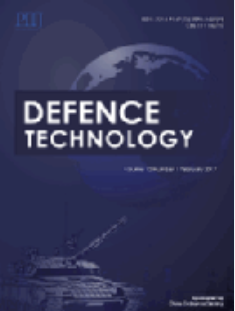不同弹丸速度下流芯惠普尔护盾超高速冲击性能分析
IF 5.9
Q1 ENGINEERING, MULTIDISCIPLINARY
引用次数: 0
摘要
惠普尔护盾作为牺牲的缓冲器,保护卫星免受极快的、不同大小的发射体在近地轨道上穿越太空的伤害。典型的惠普尔护罩由前后板组成,由间隙或空间隔开。最近的进展已经探索了使用泡沫,蜂窝芯和替代材料,如陶瓷代替铝板。本文通过数值方法探讨了在前后板之间夹入流体芯(空气/水)对超高速冲击响应的影响。数值模拟包括一枚直径为2mm的不锈钢弹丸以3-9 km/s的速度以正常轨迹向惠普尔盾发射的超高速撞击。前后保险杠材质为AA6061-T6,厚度均为1mm。在两板之间留出10毫米的空间(被液体占据)。分析的关键指标是射孔特征、碎屑云产生和传播的阶段、能量变化(内部功、动力学功和塑性功)、温度变化和碎片汇总。计算分析表明,在Whipple护盾中采用水芯可以防止后保险杠射孔至6 km/s,降低前保险杠射孔区和碎片尖端的峰值温度,产生更少、更大的碎片。本文章由计算机程序翻译,如有差异,请以英文原文为准。
Performance analysis of fluid-core Whipple shields under hypervelocity impact at different projectile speeds
Whipple shields as sacrificial bumpers, safeguard the satellites against extremely fast, different-sized projectiles traveling through space in the low earth orbit. Typical Whipple shields comprise a front and rear plate, separated by a gap or space. Recent advancements have explored the use of foam, cellular cores, and alternative materials such as ceramics instead of aluminium for the plates. In the current work, the effect of including fluid cores (air/water) sandwiched between the front and rear plates, on the response to hypervelocity impact was explored through a numerical approach. The numerical simulation consisted of hypervelocity impact by a 2 mm diameter, stainless steel projectile, launched at speeds of 3–9 km/s with a normal impact trajectory towards the Whipple shield. The front and rear bumpers, made of AA6061-T6, were each 1 mm thick. A space of 10 mm was taken between the plates (occupied by fluid). The key metrics analyzed were the perforation characteristics, stages of the debris cloud generation and propagation, energy variations (internal, kinetic and plastic work), temperature variations, and the fragmentation summary. From the computational analysis, employing water-core in Whipple shields could prevent the rear bumper perforation till 6 km/s, lower the peak temperatures at the front bumper perforation zones and debris tip, and generate fewer, larger fragments.
求助全文
通过发布文献求助,成功后即可免费获取论文全文。
去求助
来源期刊

Defence Technology(防务技术)
Mechanical Engineering, Control and Systems Engineering, Industrial and Manufacturing Engineering
CiteScore
8.70
自引率
0.00%
发文量
728
审稿时长
25 days
期刊介绍:
Defence Technology, a peer reviewed journal, is published monthly and aims to become the best international academic exchange platform for the research related to defence technology. It publishes original research papers having direct bearing on defence, with a balanced coverage on analytical, experimental, numerical simulation and applied investigations. It covers various disciplines of science, technology and engineering.
 求助内容:
求助内容: 应助结果提醒方式:
应助结果提醒方式:


